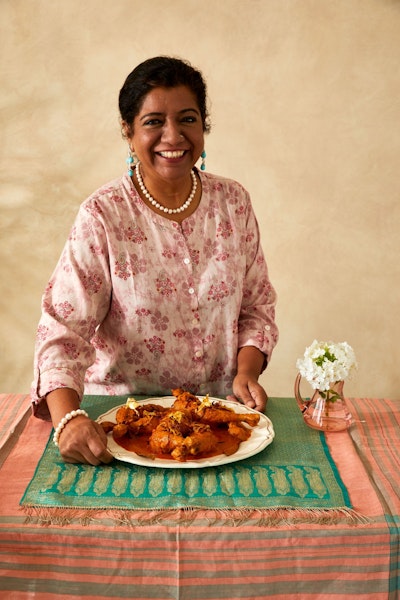A phenomenally flavourful dish.
A prawn biryani is a great alternative to a traditional meat-based biryani, and instead of prawns you can substitute pieces of firm, white fish, such as cod, or even salmon. The preparation is in two parts. First, you need to make a spiced prawn base, which is layered with rice, saffron and spices, and then the rice and prawns are gently cooked together to merge the flavours. As with all seafood dishes, the most important thing is not to overcook the prawns.
Serves: 6-8
Ingredients
- 700g basmati rice
- 7 tsp salt
- 1 Indian bay leaf (tej patta) or regular bay leaf
- 4 green cardamom pods
- 2 cloves
- 5-cm piece of cassia bark (or cinnamon stick)
- 1 tbsp ghee
Saffron Layer:
- 1 tsp saffron strands
- 100ml full-fat milk
Prawn Layer:
- 4 tbsp vegetable oil
- 100g white onion, thinly sliced
- 1/2 tsp sugar
- 4 tbsp ghee
- 175g onions, blitzed to a paste in a food processor
- 1 tbsp ginger paste
- 1 tsp garlic paste
- 1/2 tsp ground turmeric
- 1 tsp ground cumin
- 1 tsp ground coriander
- 1 tsp chilli powder
- 3 small red tomatoes, chopped
- 1 tsp salt
- 500g raw peeled prawns, deveined
METHOD
Wash the rice in a bowl of cold water, moving your hand in gentle circular movements in one direction to avoid breaking the delicate tips of the rice (if they are broken they will form a glue-like starch that will make the rice sticky). Change the water several times until it is no longer cloudy. Soak the rice in cold water for 1–3 hours.
Put the saffron in a small bowl, warm the milk to tepid and pour over the saffron. Set aside.
To make the prawn layer, heat the oil in a heavy-based pan over a medium–high heat. To check that the oil is hot enough, take a slice of onion and dip the tip into the oil – it should immediately start to sizzle. If not, wait for a few more minutes before adding all the sliced onion. Sprinkle the sugar over the onion and fry for 15–20 minutes or until caramelised. As the onion starts to turn golden brown, keep stirring to ensure it fries evenly. Using a slotted spoon, remove the onion to a plate, leaving as much of the oil in the pan as possible. Separate the onion with a fork and spread across the plate so it crisps as it cools.
Put the pan back over a medium–high heat and add the ghee, quickly followed by the onion paste, ginger and garlic pastes and stir for 2–3 minutes. Add the turmeric, cumin, coriander and chilli powder and stir for a minute. Add the tomatoes and salt and pour about 2cm of water over the contents of the pan, then cook until the liquid starts to reduce and thicken, and you can see oil at the edges of the tomato mixture. Add the prawns and cook over a high heat for 2–5 minutes, stirring to ensure all the prawns are cooked, but taking care not to overcook them. Remove the pan from the heat and set aside, uncovered. There should be a thick clingy sauce around the prawns.
Use a large pan to boil the rice. Boil the kettle and fill the pan up to three-quarters of its depth with boiling water. Drain the rice and add to the boiling water together with the 7 teaspoons of salt, bay leaf, cardamoms, cloves and cassia. Boil the rice until it is three-quarters cooked (this should not take more than 5 minutes). This is important as it will go through another cooking process. To test, remove one grain of rice from the boiling water and press it between your fingers. The outside should be soft but there should still be a hard inner core in the grain of rice. When the rice reaches this stage, drain in a colander and then spread the rice out on a couple of large plates to prevent it from continuing to cook.
To assemble the biryani you will need a heavy-based pan with a tight-fitting lid. First add half the rice. Add ½ teaspoon of the ghee and half the saffron milk and stir gently to ensure the ghee and milk spread evenly.Then add the prawn mixture, including any sauce. Sprinkle a quarter of the caramelised onions on top of the prawn layer followed by the remaining rice. Add the remaining saffron milk and the remaining ghee. Sprinkle another quarter of the caramelised onions on top. Put the pan over a high heat and wait until you can see some steam coming through from more than one area. When the steam is coming through evenly, cover the pan tightly and turn the heat to low. After 15 minutes, turn off the heat and leave undisturbed for 10 minutes.
Remove the lid and gently mix the layers. Garnish with the remainingonions before serving.















